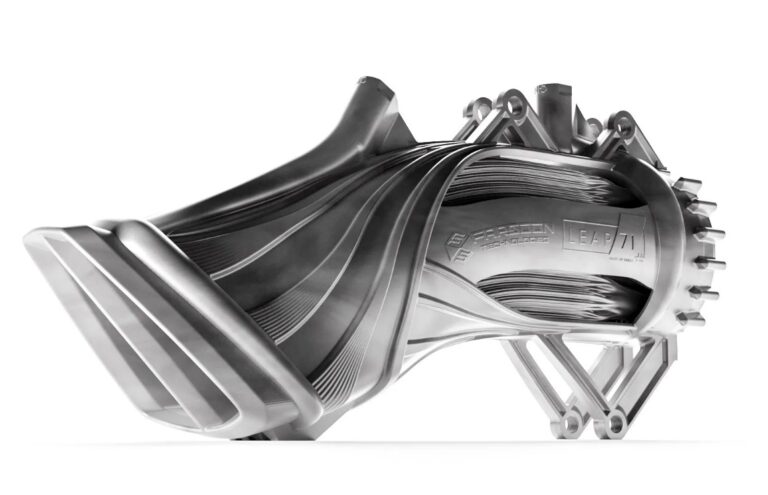A Giant Leap for Spaceplanes: How Computational Engineering and 3D Printing Are Unlocking SSTO Flight
Dubai, UAE / Changsha, China – For decades, the concept of a single-stage-to-orbit (SSTO) vehicle—a spacecraft that takes off from a runway like a plane and reaches orbit in one smooth, continuous ascent—has been the holy grail of aerospace engineering. The immense technical challenges have kept it largely in the realm of science fiction. Until now.
In a landmark collaboration, LEAP 71 and Farsoon Technologies have announced the successful creation of a large-scale hypersonic precooler, a critical component that brings the dream of practical, air-breathing launch vehicles tangibly closer to reality.
The Vision: Winged Spacecraft and Air-Breathing Engines
The key to efficient SSTO flight lies in an engine that can “breathe” atmospheric air during the initial ascent, much like a jet engine, before switching to an onboard rocket propellant for the final push into the vacuum of space. This air-breathing phase drastically reduces the amount of heavy oxidizer a vehicle needs to carry, promising fully reusable, aircraft-like operations for space access.
“The dream of winged spacecraft has always hinged on propulsion systems that breathe air at hypersonic speeds before transitioning to rocket mode,” said Lin Kayser, Co-Founder of LEAP 71. “By combining Computational Engineering with large-scale metal Additive Manufacturing, we now have a shot at overcoming some of the most fundamental barriers to realizing that vision.”
Conquering the Hypersonic Furnace
The core of this breakthrough is the precooler, a 1.5-meter-tall marvel of engineering designed to tackle one of the most extreme problems in hypersonic flight: heat.
“At hypersonic speeds, incoming air can reach several thousand kelvins due to stagnation effects,” explained Josefine Lissner, Managing Director of LEAP 71 and Principal Architect of their Noyron system. “To manage these extreme temperatures, we implemented a fractal folding algorithm in Noyron to maximize the available surface area without compromising aerodynamic flow. The intertwined structure separates the superheated air from the liquid-hydrogen coolant, enabling rapid thermal exchange in a compact, manufacturable form.”
In essence, the system acts as a hyper-efficient radiator, cooling the scorching incoming air to a temperature the engine can safely handle, all while maintaining a lightweight and aerodynamically sound structure.
From Digital Blueprint to Physical Giant
Turning such a complex computational design into a physical object required equally advanced manufacturing capabilities. LEAP 71’s Noyron system generated the design, and Farsoon Technologies brought it to life on their FS811M-U-8 printer, one of the world’s largest metal Additive Manufacturing platforms.
The two teams worked in lockstep to fine-tune the manufacturing process, successfully producing one of the tallest metal powder-bed fusion parts ever built.
“This collaboration demonstrates how the convergence of large-format metal additive manufacturing and AI-driven design can redefine the limits of aerospace engineering,” said Oliver Li, General Manager of Farsoon Europe GmbH. “Farsoon’s open, industrial-scale LPBF systems empower partners like LEAP 71 to transform digital intelligence into tangible high-performance components — proving that innovation and collaboration are the true engines driving the next generation of space technology.”
A New Trajectory for Space Access
This achievement is more than just a technical milestone; it’s a statement of intent. The companies aim to reignite the discussion about reusable spacecraft and broaden the focus beyond the current paradigm of vertical takeoff and landing rockets toward a future of runway-launched spaceplanes.
See the Future in Frankfurt
The finished hypersonic precooler will be publicly exhibited for the first time at Formnext 2025 in Frankfurt, at the Farsoon booth (Hall 11.0, Booth E11).
About the Companies
About Farsoon Technologies
Farsoon Technologies, founded in 2009, is a global manufacturer and supplier of industrial-level polymer and metal Laser Powder Bed Fusion (LPBF) systems. With a vision to provide truly open and industrial additive systems, Farsoon is a leading supplier of AM technology in China with growing international reach. https://www.farsoon-gl.com
About LEAP 71
LEAP 71, strategically based in Dubai, UAE, is a pioneer in Computational Engineering. Its core technology, Noyron, is a Large Computational Engineering Model that autonomously designs physical objects by encoding logic, physics, and production methodologies. The company focuses on accelerating engineering across aerospace, electric mobility, robotics, and thermal systems, with a key goal of extending humanity’s footprint in space. https://leap71.com
